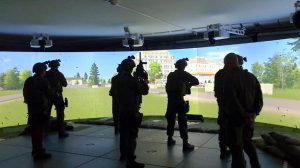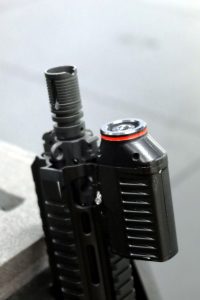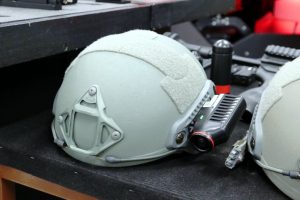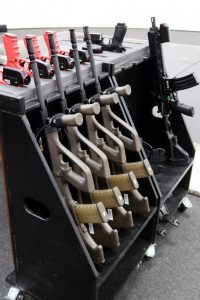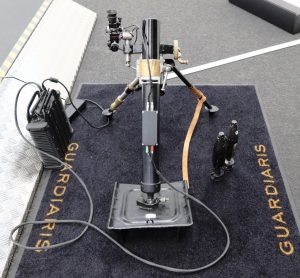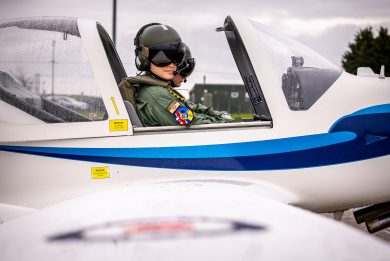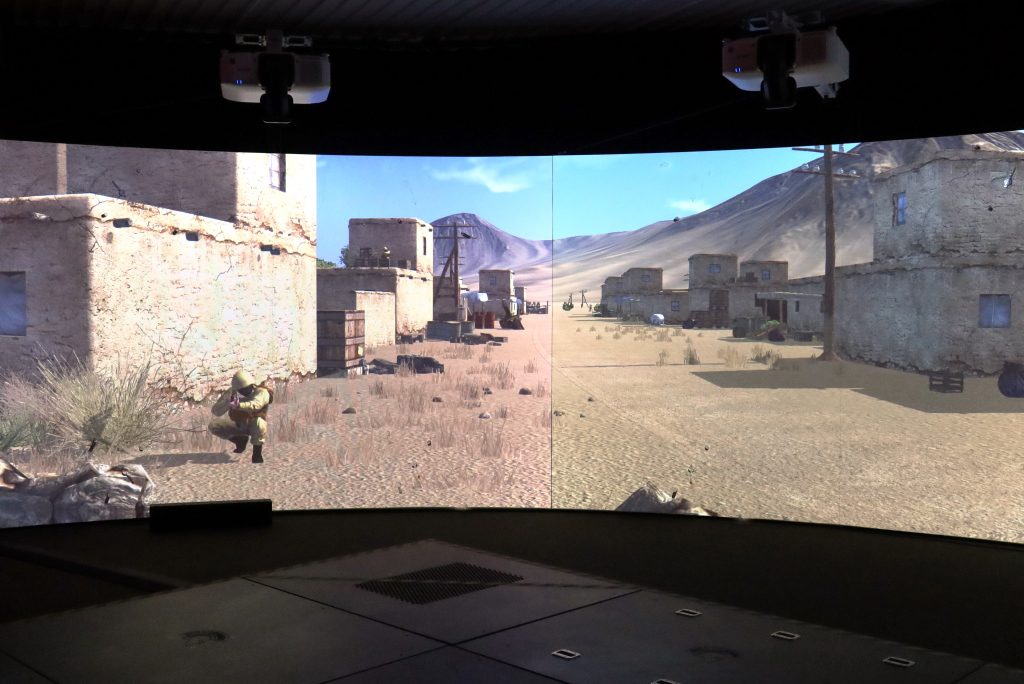
The Austrian Army officially presents its new indoor small arms trainer
The six-man team awaits the situation to evolve. The village is known to be infested by insurgents, however none of them is in sight. Suddenly a movement catches the attention of one of the Austrian soldiers who brings to bear his Steyr AUG assault rifle, Sturmgewehr 77 or StG 77 [1] in Army wording, and opens fire, while his mates continue scanning the remaining area. A heavy vehicle is approaching, and the six soldiers can feel it from the incoming sound and the vibration under their feet, thanks to the sound/shock floor on which the trainees are standing, which is activated by the system computer together, loudspeakers providing a surround feeling and adding a considerable realism that increases the stress factor during the action. In the mean time a group of opponents appears in the scenario, and is engaged by the MG 74 machine gun operated by a seventh soldier. Opposing forces, in the form of avatars and vehicles of various types, are managed by artificial intelligence (AI) algorithms, with inputs from the instructor console.
All this scene takes place inside a room, thanks to the new simulation system adopted by the Austrian Army, the Bundesheer having acquired five such systems from Guardiaris, a Slovenian company based in Ljubljana, which has developed a suite of simulation assets that are attracting the interest of various OEMs and end users.
On April 5th the Austrian MoD organised the official presentation of its new small arms simulator A-SATT. The event took place at Bruckneudorf, some 30 km south-east of Vienna, within the opening ceremony of that completely renovated and modernized military training area. Beside numerous high military ranking officials, the event was attended by Klaudia Tanner, the Federal Austrian Minister of Defence.
Known as SATT, for Small Arms Tactical Trainer, the system in use in Austria is based on various elements and differs from solutions proposed by other simulation companies; most such systems are based on a laser installed in the add-on fitted to the weapon, sensors on the screen understanding where the weapon is aimed. On the contrary the Guardiaris SATT works on a patented IR technology; the SAS (Small Arms System) module gathers data on shooters behaviour and weapons’ movements in 6D, providing both position and orientation. The SATT baseline configuration is made of four screen elements each covering 37.5° for a total of 150°. The SAS module has a size and weight similar to that of the Glock tactical light [2] and is usually fitted to the front Picatinny, however in the StG 77A2 it is integrated in the optical sight. Accelerators sense the movements and recognise the shock of the trigger mechanism, which differs from other possible inputs. All data exchange between the SAS, which can be fitted either onto a real weapon or a replica, and the main computer are ensured via WiFi.
Compared to other systems the SATT provides total freedom of movement to the soldier and does not require any add-on element to the clothing and personal equipment. One exception is the SAS added to the helmet: this allows to track head movements, an important element in After Action Reports (AARs) as it permits to understand the behaviour of the single soldier during the exercise, i.e. if the six military, the usual number of soldiers deployed on the SATT, are covering the whole 150° frontal arc ensuring optimal situational awareness. In the Austrian Army setup the machine gunner sees the scenario on a separate screen with a 37.5° field of view. In the SATT the scenario moves towards the soldiers, the speed depending on the instructor and on results obtained in the confrontation.
It is here the right place to mention the Guard software used to generate SATT scenarios. Contrary to many other simulators, the Guardiaris proprietary software is not a standard scenario generator used in the gaming world. Although it exploits similar technologies, the Guard 1.0 is specifically designed to cope with the needs of the small arms trainer, hence it is much lighter, employs less computing power, and can thus be run on a single machine with embedded computer, which makes the SATT easily portable and deployable. It allows generating scenarios on a 40 x 40 km area, the time needed depending not so much on the graphic accuracy but mostly on the physical characteristics of the various elements, which are needed to ensure maximum reality coupling their reaction to the type of threat that hits them, the effects of the weapons modifying the scenario during the exercise,
Beside the assault rifle and the machine gun, the Austrian SATT configuration also includes the Glock 17 handgun, known as Pistole 80, and the Steyr GL 40 single-shot grenade launcher, defined by the Bundesheer ML 40 Mk1, the latter weapon providing indirect fire, the laser-less system sensing the angle of the sight, generating the corresponding trajectory and point of impact of the 40 mm grenade. Of course all atmospheric conditions are well kept into consideration and not only modify the visual but also influence shooting results.
It is quite obvious that the amount of data provided by the Guardiaris tactical simulation is much higher than that provided by laser-based systems, therefore technologies used to treat Big Data, as well as machine learning and AI are used to handle them and provide the instructors with information made available by the laser-less technology that allow consider unprecedented behaviour details, which permit evaluating at best soldiers performances.
Guardiaris anti-tank, mortar and even military vehicle simulation systems exploit the same technology used in the SATT, and can therefore be easily integrated into it. Known as MATS (MANPATS Training System) the antitank weapon simulator has been developed for numerous light manportable systems. A replica of the actual weapon system is used, which respects all dimensional, weight and centre of gravity figures, the launch tube
hosting the computer, the battery and the equivalent of the SAS module. A dedicated software allows to virtually reproduce the weapon’s characteristics in terms of range, external ballistics, terminal effect depending on the type of munition or warhead, etc. In the mortar simulator, known as IMOT (Indoor MOrtar Training), “smart ammunition” allows verifying if the weapon crew input the right fuse setting, loaded the round with the right charge, while of course the aiming sight settings are also kept under scrutiny and considered in the ballistic equation.
Small arms simulation is only one of the activities of Guardiaris. The company is in full growth and is closing the target of 100 employees. Currently split among various facilities within Ljubljana, it will soon move into a single building which has been refitted on purpose, and will host both the production lines, the demonstration theatre, and the offices at the first floor. The average age among Guardiaris personnel is pretty low, probably under 35, 39% of them with an engineer degree, 25% with a master degree, and 16% of them with a PhD. Innovation is a daily issue, and while actively marketing its current portfolio, the Slovenian company looks ahead with new ideas. “Next June we will be at Eurosatory in force, and we will definitely exhibit in Paris some new products that will further strengthen our catalogue, increasing flexibility, and giving a plus to our customers,” Primož Peterca, the founder and CEO of the company tells EDR On-Line.
According to the press release issued by the Bundesheer the service has five such systems deployed throughout the country, the programme cost being evaluated at 5 million Euro. The document also stated that two more systems are planned.
Photos courtesy Austrian Army and P. Valpolini
[1] The Austrian Army fields four different models of assault rifle, the basic StG 77 A1, the StG 77 A2 in service with Special Forces (Jagdkommando and Jägerbataillon 25), the StG 77 KPE (Kaderpräsenzeinheiten) for units deployed on operations, and the StG 77 A1 MP in use by Military Police, the latter three being fitted with Picatinny rails to host sights and accessories. The Guardiaris SATT provided to the Austrian Army can work with all four versions, the barrel length being modified by inserting or removing an add-on element.
[2] The Glock GL21 tactical light, i.e., is 51 mm high, 82.5 mm long, 31 mm wide, and weighs 92 grams with batteries.

